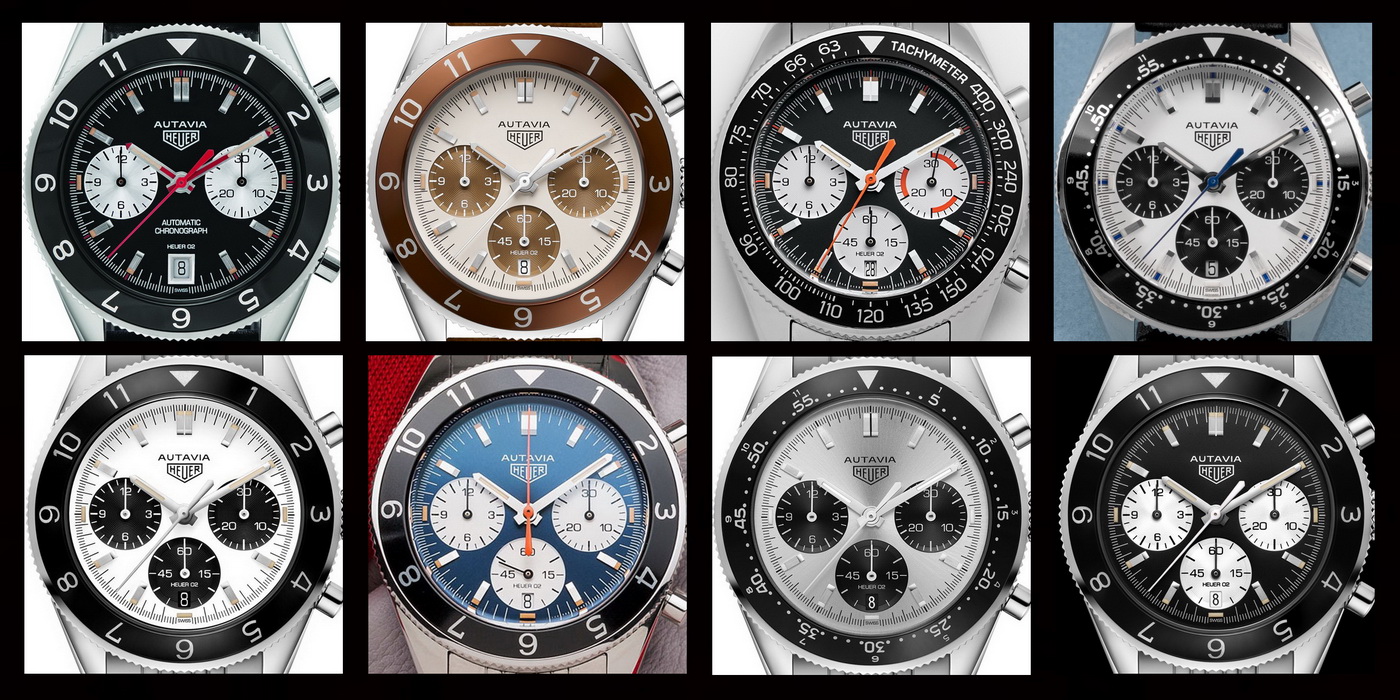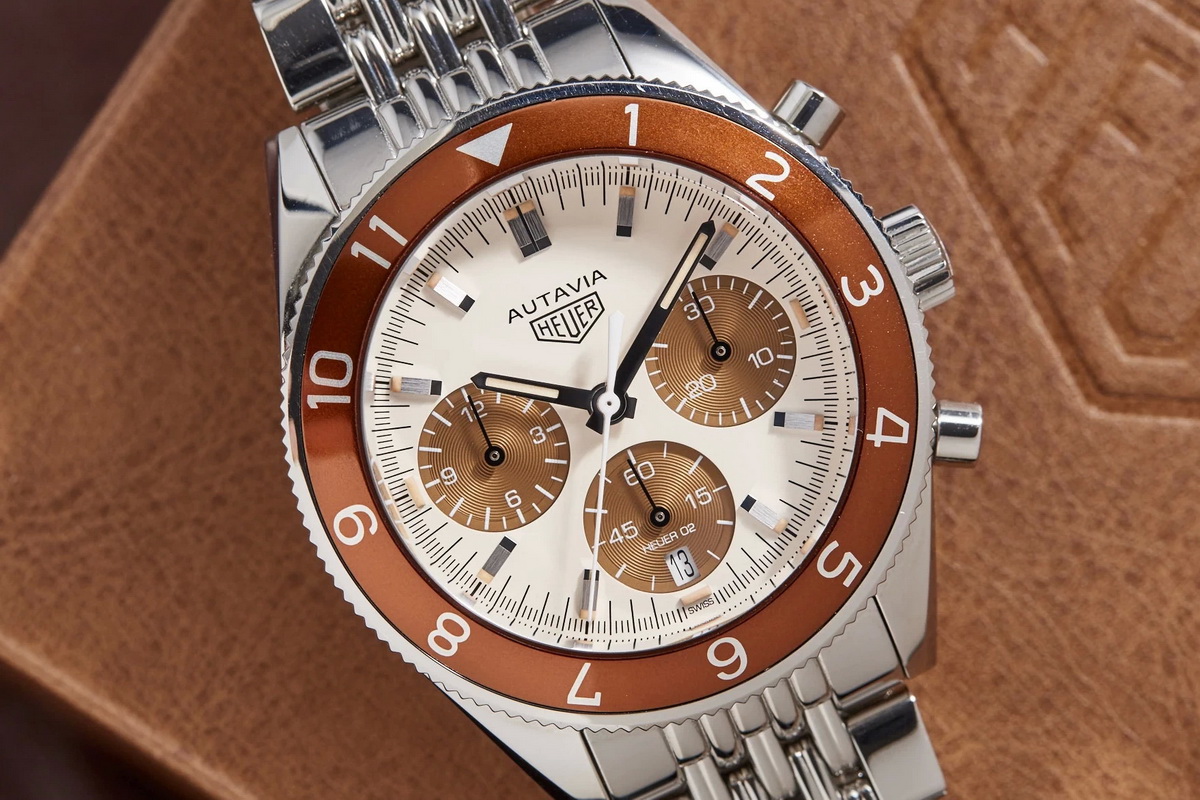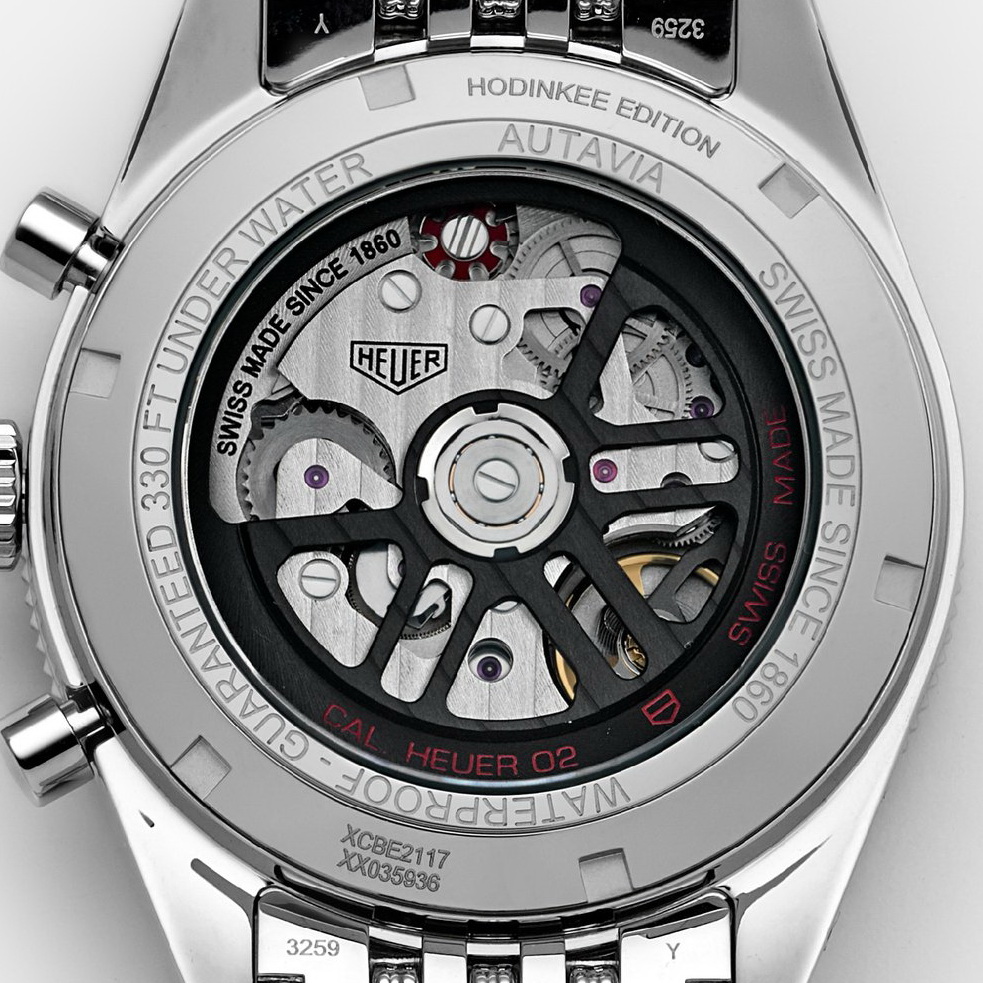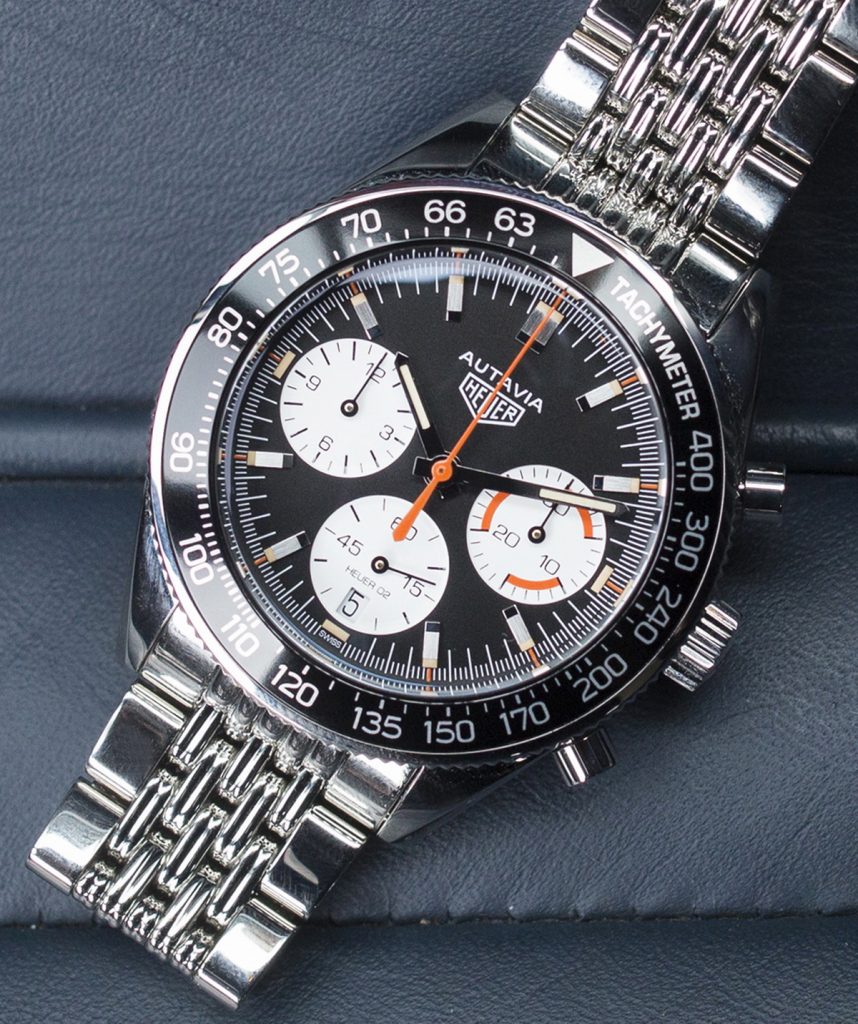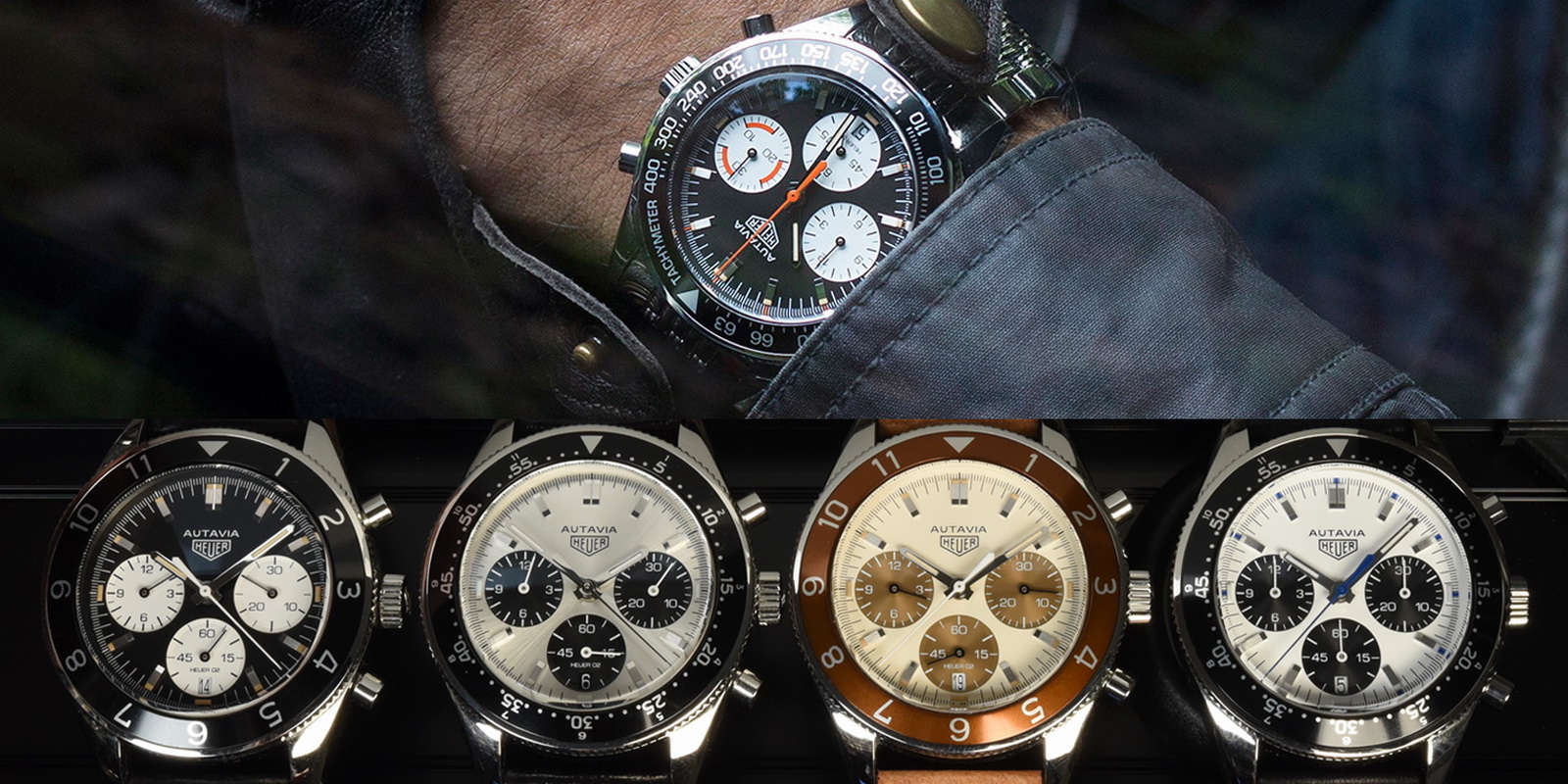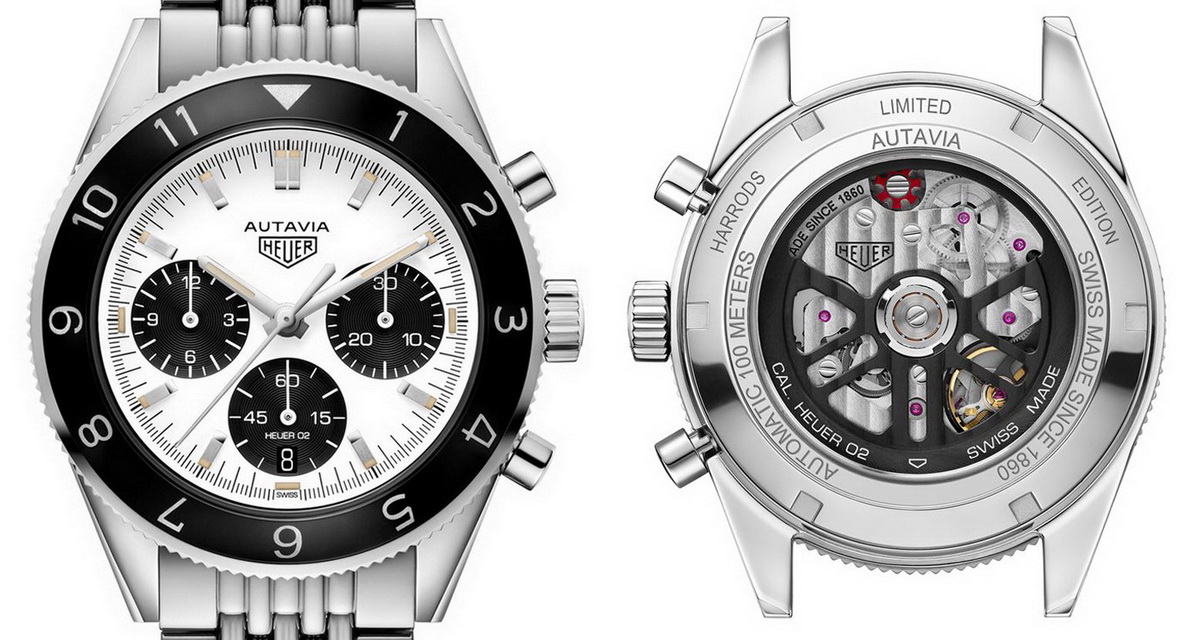In our original May 2018 posting, we covered the original “standard production” Autavia, that was introduced in March 2017, as well as four of the Autavia models that were introduced over the 14 months. As it appears that this first generation of the TAG Heuer Autavia re-editions is coming to a close, in this February 2020 posting, we cover an additional three models of the Autavia, so that we have now a total of eight models, as follows:
- 2017 March — TAG Heuer Autavia (CBE2110) — standard production model of the Autaviaa
- 2017 November — Jack Heuer Limited Edition Autavia (CBE2111)
- 2017 November — Limited Edition Autavia for the UAE (CBE2113)
- 2018 February — Calibre 11 Limited Edition Autavia — Siffert Edition (CBE2114)
- 2018 February — Harrods Limited Edition Autavia (CBE2116)
- 2018 May — “Orange Boy” Autavia, exclusively for Hodinkee (CBE2117)
- 2018 November — “Viceroy” Autavia, for the United States Market (CBE2118)
- 2018 November — Watches of Switzerland Limited Edition Autavia (CBE2115)
Original Posting — May 2018
Writing about watches (or just about anything else) can be frustrating.
In February, I was excited about the four Autavias that TAG Heuer has introduced over the past year, and I have two of them in my collection. I wanted to write a review of all four models, so I borrowed the two that I didn’t own; spent a couple of evenings with my camera; tapped out the first thousand words of a posting; and seemed ready to post the definitive review of these four TAG Heuer Autavias. It was mid-March and I was half-way done with the posting . . . this was smooth sailing, all the way.
It would be a fun posting. Others have written detailed reviews of these four Autavias, but I was enthusiastic about publishing the first posting to cover all four of them, side-by-side. And I couldn’t imagine that anyone else had strapped all four models to a box level, suspended them with Manfrotto Magic Arms, put them under 2000 watts of light, and taken the family photo. Yes, I was excited about this posting.
The first sign of trouble came with the request from a friend at Hodinkee to borrow my vintage “Orange Boy” Autavia for a photo shoot. Suspicion morphed into alarm when the crew at Hodinkee shared a photo showing the fifth new Autavia that would be introduced, toward the end of May. Officially, this fifth Autavia is called the “TAG Heuer Autavia Calibre Heuer 02 for Hodinkee”, but we can be sure that it will forever be called called the “Orange Boy”.
So what am I supposed to do with these photos of the “First Four” Autavias? I was proud that these four watches had gotten a lot of wrist time, and that I had recorded my impressions of each of them. Now, I was left with the announcement of a fifth model, but I would not be able to actually see or wear this watch. Damn. Why hadn’t I published this “Definitive Review” of the first four Autavias back in March, as I had originally planned? With a couple of days notice that the newest Autavia would be announced on May 31, I had exactly 36 hours to rework / rewrite / refinish / restore / re-whatever, so that my posting would coincide with Hodinkee’s announcement of the new watch. “Dewey Defeats Truman” was a headline for the ages, and I seemed to be stuck with “TAG Heuer Offers Four Autavias”.
Oh well. No time to think about what might have been. Instead, it was time to provide some perspective and impressions of the five Autavias now offered by TAG Heuer. As scheduled, on May 31, Hodinkee announced the arrival of the new “Orange Boy” Autavia.
Origin of the Autavia Species.
There are two basic varieties of vintage Autavias. From 1962 through 1969, the Autavia used a traditional round case, with manual-winding movements (generally, Valjoux 72 for the three register models and Valjoux 92 for the two register models). With its introduction of automatic chronographs in 1969, the Autavia moved to a larger c-shape case, with these larger cases being used for both the automatic and manual-winding models from the early 1970s into the 1980s. Common features across all Autavias included stainless steel cases and rotating bezels. Variations across the product line included dials in black and white, with pewter and champagne coming in the 1980s; GMT models with a special hand and bezel to track a second time zone; and even colored cases, toward the very end of the Autavia’s production.
In late 2015, when Jean-Claude Biver announced that TAG Heuer would again be offering the Autavia, he stated two criteria for the watch. The new Autavia would be in a traditional round case and it would be a “modern size”, say 42 millimeters. Beyond these criteria, Biver announced that the enthusiasts of the brand could select the configuration of the new model.
At Baselworld 2016, TAG Heuer announced that enthusiasts would choose the look of the new Autavia through the “Autavia Cup” competition. Using a head-to-head, knock-out format, participants made their choices from among 16 vintage Autavias. Voters could make their choices between two registers or three; dials in black or white; and oversized registers (as on the first models) or standard-sized registers (as on the later ones). After voters narrowed the field to four choices, TAG Heuer would make the final choice of the newest Autavia.
The winner of the Autavia Cup was a version of the black-dialed, three-register Autavia produced circa 1967, worn by Formula One champion Jochen Rindt. Known to collectors simply as the “Rindt” Autavia, this model featured the smaller registers and simple matchstick style hands. The Rindt models were sold with bezels marked for hours, minutes or a tachymeter scale.
What They Share — Features of the TAG Heuer Autavias
Before we review the five TAG Heuer Autavias offered since March 2017, it is helpful to review the features that they share. The dials of the new Autavias are arranged in the traditional 3-6-9 (tri-compax) approach, with the hour register at nine o’clock and the minute register at three o’clock, with running seconds at six o’clock. The date window is placed at the bottom of the running seconds register.
Cases are stainless steel, with all surfaces polished. The bezel rotates in both directions, with 60 clicks along the way. The case measures 42 millimeters across the dial, with a thickness of 16 millimeters (from the back of the case-back to the top of the crystal), and a measurement of 50.5 millimeters from lug to lug. The case measures 21 millimeters between the lugs. Water resistance is stated to be 100 meters, making the watch reliable for everyday wear.
The movement is the Heuer 02, which was designed by TAG Heuer and is produced in-house. The Heuer 02 is a column wheel actuated chronograph with a vertical clutch, that beats at a rate of 28,800 VPH, with a power reserve of 75 hours. The movement has 33 jewels, and measures 31.0 millimeters by 6.95 millimeters.
The 2017 TAG Heuer Autavia – The Black
Origins
As described above, the 2017 TAG Heuer Autavia was derived from the Rindt Autavia, from the mid-1960s. The dial is matte black with applied metal markers; the registers are standard-sized; and the hands are a simple matchstick shape. This three register model is associated with Formula One champion Jochen Rindt; the similar two-register model was worn by another Formula One champion, Mario Andretti.
Impressions
TAG Heuer’s new Autavia has generally met with favorable reviews over the last year. While the move from the 39 millimeter case of the original Rindt to the 42 millimeter case of the new Autavia drew some fire, the watch “wears well”, in part because the lugs have been shortened. The Heuer 02 movement has been well-received, keeping good time and with the chronograph (start / stop / reset) operating smoothly. As beads-of-rice bracelets for the 1960s Autavias topped the $5,000 mark, some marveled that one could now buy a reliable, modern watch on the same style bracelet, as around this same price.
The new Autavia has occupied a good place in my collection over the last year. It’s a “grab and go” watch, that sets quickly, runs and operates well, and is comfortable to wear. The extended power reserve is also useful, for those times when the watch is in the current rotation, but resting in the drawer for a day or two. For example, being able to put it down on Monday evening and pick it up Thursday morning, without resetting the time, adds some convenience.
The Jack Heuer Limited Edition Autavia – The Jack
Origins
At the time that TAG Heuer released the first Autavia in March 2017, there were loud whispers and abundant leaks that the black version would be followed by a white / silver limited edition, in honor of Jack Heuer’s 85th birthday, in November 2017. The “panda” scheme for an Autavia (white dial / black registers) had its origins in some test / prototype dials that Heuer procured in the late 1960s, with collectors generally agreeing that the watches using these dials had been assembled in recent years, with none being offered in the 1960s. Still, the handful of these silver-dialed Autavias that were assembled from the loose dials from the 1960s had good success in some recent auctions, laying the foundation for the production of the Jack Heuer Limited Edition.
Jack Heuer had his hand in the design of this Autavia, for example, specifying that the lume should be bright white, rather than having the aged look of the standard black model. The case-back has the Heuer family shield, along with a reproduction of Jack Heuer’s signature.
The Jack Heuer 85th Birthday Edition is limited to 1,933 watches, to coincide with the year of Jack Heuer’s birth.
Impressions
While my black, standard-issue TAG Heuer Autavia has been a regular in my watch rotation, the Jack Heuer Limited Edition has been a watch for special occasions. Yes, the bright silver / white dial and the contrasting black registers and bezel look great with a bright white shirt and dark suit, or with a charcoal sweater, but as office attire has trended to the more casual look, this dressier style Autavia has gotten the call less frequently. Perhaps the most significant negative of the watch is its legibility (or the lack of legibility), as the silver hands sometimes disappear on the silver / white of the dial. The MH (minutes / hours) bezel is a plus factor, reducing the apparent width and weight of the bezel insert. Bottom line — it’s a good looking watch, when you are in the mood for a “dressy” looking Autavia.
The Autavia Limited Edition for the UAE
Origins.
Dubai Watch Week was held in November 2017, and to commemorate the event retailer Ahmed Seddiqi & Sons created a limited edition of 150 Autavias, that would be available only through TAG Heuer retailers in the UAE. The dial has a soft cream tone, the registers are somewhere between caramel and bronze, and the bezel is a rich shade of brown. The warmth of these elements is complemented by the aged look of the lume on the markers and hands. The chronograph second hand is bright white, and the “needles” on the registers are black.
The UAE Limited Edition Autavia was limited to 150 pieces, and the series sold out soon after it was released. You can read the Hodinkee report on the UAE LE Autavia HERE.
Impressions
When I first saw this watch (on my computer screen), my immediate reaction was “WTF?” Yes, the watch collecting world has gone mad for the tropical dials, faded bezels and aged lume, but this Autavia seemed to have gone too far. We want them to age over the decades, not by virtue of a designer selecting the rarely-used Pantone swatches. I was genuinely surprised that several well-respected collectors of vintage Heuer chronographs seemed to be taken by this watch. Several of them went to extraordinary efforts, sourcing the watches from half way around the world. Literally.
On the wrist, this watch was nothing short of spectacular! The individual colors of the dial, registers, bezel and lume are so sublime, so different from each other, but perfectly balanced and complementary with each other. I’m not sure that I would want it as my only watch, to wear 24/7/365, but for the collector who has a lot of black watches and a lot of white watches, and even some orange, blue and green watches, the colors of the UAE Limited Edition offer something very different, something very appealing. Of the four Autavias that shared the month of March on my wrist, the UAE Limited Edition was the one that I found myself admiring most frequently over the course of a day.
The Calibre11 Limited Edition Autavia – Siffert Edition
Origins
Over the period from the introduction of the Autavia in 1962 until the introduction of its automatic models in 1969, Heuer pretty well stuck to black dials and white registers for the Autavia. Red accents came fairly late in the decade, used in moderation on the second execution Reference 2446C. With the introduction of the automatic Autavias in 1969, however, Heuer added an entirely new color scheme – a white dial, black registers, and blue accents used on the dial and – eventually – the hands. Swiss Formula One hero Jo Siffert wore this model, and the entire line-up of these white-dialed models are now known as the “Siffert” Autavias. Over the period from 1969 through the mid-1970s, Heuer produced at least six versions of the automatic “Sifferts”, with three manual-winding models completing the line-up.
Introduced in February 2018, the Calibre11 “Siffert Edition” of the Autavia faithfully incorporates the color scheme of the vintage Siffert models onto the new TAG Heuer Autavia. We see the white dial, black registers and blue accents (on the dial and on the chronograph second hand), with the same balance as on the vintage models. The Siffert connection is reinforced through a reproduction of Jo Siffert’s signature, on the sapphire section of the case-back.
The Siffert LE was limited to 100 pieces, and the series sold out soon after it was released. You can read the Hodinkee report on the Calibre11 Siffert LE HERE.
Impressions
When I first saw the Calibre11 Siffert Edition, the often-too-literal Jeff Stein was horrified – How could anyone incorporate the Siffert colors (which were introduced in 1969 and always resided in a c-shape case) into a traditional round case, that was being phased out at that exact moment in time? If this watch were a movie, wouldn’t it have a screaming “continuity” problem?
Thinking about the watch world in the year 2018, however, I quickly came to terms with the idea of the Siffert LE. TAG Heuer had selected a traditional round case for new Autavias and – mercifully – we are unlikely to see the recreation of the c-shape cases of the 1970s. So if we want a tribute to Jo Siffert, and if we want the fantastic Siffert colors, then we will have to have them in a traditional round case. If we can put aside the literalism and put aside being locked into the case-color combinations from 50 years ago, then we can have some fantastic looking watches, inspired by Heuer’s history. Yes, we can have Heuer’s vivid colors of the 1970s, but they will be framed by a traditional round case, as was used during the 1960s. That, my friends, is the reality of TAG Heuer Autavias in the late 2010s.
A side-by-side comparison of the Calibre11 Siffert Limited Edition with the three-register model from the 1970s (Reference 73663) confirmed that, at arm’s length, the new Autavia has the same basic appearance as the vintage model, even if the cases have different shapes. My eyes tend to focus on the white / black / blue of the dial and bezel, with the shape of the case being a secondary factor.
Wearing the watch back in March, I decided that if I could only have one of the four TAG Heuer Autavias, the Calibre11 Siffert LE would be the one. Yes, the original black one is the “classic”, the Jack Heuer LE is great for the right occasion, and the UAE Autavia has the cool, for-the-weekend factor, but the Siffert LE is just a fantastic looking watch. If I had a couple of black watches in my collection and wanted to add a modern, white watch to my collection, this would be an ideal choice. It’s that simple. The fact that vintage Sifferts sell for much higher prices than the standard black models from the 1970s is another reason for the vintage enthusiast to add the Calibre11 Siffert LE to his or her collection.
The TAG Heuer Autavia for Hodinkee – Orange Boy
Origins.
As we have described, during the 1960s, used two colors for the Autavia – a lot of black (for the dial) and a little white (for the registers). By the late 1960s, some red accents had crept in, and with the development of the “Siffert” model in 1969, we saw a white dial, with black registers, and blue accents.
By 1971, it was time for Heuer to broaden its range of colors, and so the black dial of the standard Reference 1163 Autavia was modified, with vibrant orange accents. These accents on the dial included thin lines outside each of the hour markers, and three thick stripes on the chronograph minute recorder (sometimes called “racing stripes”). The orange accents were carried over to the brushed hands, which have orange inserts and orange triangular tips. The first Autavia to incorporate these elements was the Reference 1163, known among today’s collectors as the “Orange Boy”. Many later Autavias would use orange accents; many later Heuer chronographs would use the racing stripes on the minute recorder, but both these elements originated with the “Orange Boy”.
For the sake of clarity, it is useful to compare the Orange Boy Autavia with the very well-known and relatively common Viceroy model. Take a standard Viceroy Autavia; change every accent that is red on the Viceroy to orange; and presto, what you have is an “Orange Boy”. Many sellers describe their Autavias as “Orange Boys”, but the only true “Orange Boy” is this Reference 1163 Autavia, circa 1971 / 1972. The genuine Orange Boys are genuinely rare, with only a handful coming onto the market over the course of a year.
Just as the Calibre11 Siffert LE takes the colors of the vintage Sifferts and incorporates them into the new TAG Heuer Autavia, so too the Hodinkee Orange Boy takes the defining elements of the vintage Orange Boy and incorporates them into the new Autavia. Orange accents by the hour markers; orange accents on the hands; orange stripes on the minute recorder. Compared with its four TAG Heuer Autavia predecessors, the Hodinkee Orange Boy offers a nice innovation with the Tachymeter bezel, again being consistent with the vintage version of the Orange Boy.
The case-back of the Hodinkee Orange Boy is generally consistent with the style of the original black model, displaying the Heuer 02 movement through a sapphire crystal.
The Hodinkee Orange Boy is not a limited edition, but will be available only through the Hodinkee Shop. The price is set at $6,050, with delivery in Fall 2018.
Impressions
With the Calibre11 Siffert Edition having gotten me over the hurdle of using 1970s colors in a traditional round case, the Hodinkee Orange Boy appears to be a faithful rendition of the vintage model. The orange accents appear to be lighter than on the vintage model, but this seems consistent with the style of the watch. The Tachymeter bezel is a huge plus for the new Autavia, having become the de facto symbol of a racer’s watch, as evidenced by the Rolex Daytona, Omega Speedmaster and countless other models.
The connection with racing heros of the 1960s and 70s is a significant credential for the vintage Autavias. With specific Autavia models associated with Mario Andretti, Jochen Rindt, Jo Siffert and Gilles Villeneuve, we see why these drivers selected these models and we connect with these heroes through the vintage models. The Orange Boy Autavia was never spotted on the wrist of any particular driver, but the style of the watch and its use of vivid orange certainly evoked the raw energy and color of 1970s motor sports.
Until it spends some time on my wrist, I am hesitant to share definitive impressions of the Hodinkee Orange Boy Autavia. The UAE Limited Edition Autavia looked bizarre on the computer monitor, but superb on my wrist. That said, the Hodinkee Orange boy looks like a fantastic design, true to the original vintage predecessor, with all the advantages of being a reliable, modern watch.
Recommendations
This is often the difficult part of a comparison posting, as we consider similar watches at particular price points. With these five Autavias, however, the choices become easier, as they reside in three distinct price ranges. Currently, we see the original black Autavia selling in the $4,000 area (street price), and the Jack Heuer Limited Edition in the $5,000 range. The Hodinkee Orange Boy will be priced at $6,050. The Calibre11 Siffert LE and UAE LE sold out quickly, so if you want one of those limited edition watches, you will need to buy one from a “flipper”, recently in the $8,000 to $9,000 range.
I like these five watches, own two of them, and believe that many vintage enthusiasts will want to add one of these Autavias to their collections. Which one should it be? Each collector will need to answer that question for himself or herself, but the range of prices may make it easier. I believe that the standard black model and the Jack Heuer Limited Edition represent good buys, at current “street” prices. The Calibre11 and UAE Limited Editions will cost twice as much as these “entry level” models, but if either of the watches winks at you, then you will probably be safe in “paying up” for the watch, as these Limited Edition watches will tend to be in the hands of committed collectors, and it seems unlikely that any real supply will overhang the market.
At $6,050, the Hodinkee Orange Boy is positioned near the mid-point of these other four models. Although not a limited edition, the Hodinkee crew knows a little something about the market for watches, and we can expect that demand will be strong and production will be limited, so that the watch will, at a minimum, maintain its price, with it being more likely that the watch will trade at a premium. Ironically, the vintage Orange Boys were never associated with a particular racer. In the year 2018, however, being associated with the Hodinkee brand will make this watch especially attractive to many enthusiasts. For better or worse, for today’s enthusiasts, the fashion choices and buying decisions are influenced more by Ben than by Jo.
After Fourteen Months and Five Autavias . . .
Fourteen months and five models after Basel 2017, we can get some perspective on the TAG Heuer Autavias, as a collection. During the Autavia Cup, some enthusiasts were concerned that with Jean-Claude Biver’s stipulation that the new Autavia would be based on a model from the 1960s, the color palette would be too limited . . . the choices were black and white; end of discussion. Considering only the two models of the new Autavia designed by TAG Heuer (Panda and reverse Panda), we can see this as a legitimate concern.
In today’s world of watches, however, we are not limited to the standard models drawn by the brands’ designers, shown in the brands’ catalogs, and offered through retailers. Today, we can rely on the “influencers” to make the connection between the brands and the community of enthusiasts. Through the work of Ahmed Seddiqi in Dubai, David Chalmers in Australia, and the Hodinkee team in New York, we have now seen “influencers” design three outstanding Autavias for TAG Heuer.
With these three models, we have seen the vibrant colors of the 1970s incorporated into a style of case that originated in the 1960s, and that’s why the influencers are influencers. We can thank TAG Heuer for re-issuing the Autavia as part of its Heritage collection, in 2017, and we can thank these three influencers for designing colorful Autavias that are of tremendous appeal to today’s enthusiasts. These three watches show us the power and potential of collaboration, in leveraging a brand’s heritage models for contemporary collectors.
Update — February 2020
In this addendum, we will provide a quick overview of the three Autavias that have been introduced over the past 18 months.
Harrods Limited Edition. In February 2018, Harrods, the London department store, introduced a limited edition of 100 TAG Heuer Autavias (CBE2116). The Harrods Limited Edition has a white dial, with black registers, and aged-looking lume on the dial and hands. This Autavia uses an hour bezel.
Quick take – If you want the pure “Panda”, this is the Autavia for you. With the exception of the faux lume, this Autavia uses exactly two colors – black and white. No blue, orange, red or tropical accents here . . . just black and white. Pure Panda.
Watches of Switzerland Limited Edition. In November 2018 Watches of Switzerland, the Australian chain of watch stores, introduced the most mysterious of the TAG Heuer Autavias (CBE2115). With the midnight blue dial, and a bright orange chronograph second hand, the “tease” photo had enthusiasts hoping for a new version of the Skipper. On introduction, however, we saw another Autavia limited edition, this one featuring the deep blue dial. Oddly, the bezel remained black, leaving the Skipper fans wondering how great this one may have looked had the bezel been colored to match the dial.
Quick take – “Midnight blue” is a sacred shade for the vintage Heuer enthusiasts, having been used on the Skippers and the Monacos, among several other Heuer chronographs. There was disappointment that this Autavia did not take the theme further, with a matching blue bezel, or even further with the “Skipper” name on the dial.
The “Viceroy” Re-Edition In November 2018, TAG Heuer introduced a model that paid tribute to one of the all-time classic Autavias, the model featured in a promotion with the Viceroy cigarette brand in 1972 (and forever known as the “Viceroy” Autavia). The story of the promotion is familiar – by sending in proofs of purchase for 10 packs of Viceroy cigarettes, members of the public could get a version of the Autavia then selling for $200 for the discounted price of $88. The red accents were first used on the Autavia in the late 1960s, and Heuer continued with the Viceroy colors into the early 1980s.
The promotion was a huge success for Heuer, not only because of the sale of 5,000 of the watches, but because of the advertisements that Viceroy ran in U.S. magazines. See my posting on Hodinkee for the full story of the Viceroy promotion.
For the Viceroy Re-Edition, TAG Heuer made a significant change in the design of the Autavia, going from a three-register model to a two-register model.
The running seconds register (at six o’clock) has been deleted, and the date window, almost hidden on the three-register models, receives the same style window as in the vintage models. The Viceroy Re-Edition uses the Hour bezel, never found on the vintage Reference 1163 predecessors, but a favorite among those who may like to track a second time zone.
Quick take – The “Viceroy” Special Edition offers a very different look from the seven other Autavia re-editions. Rather than being derived from the classic, round cases that housed the Autavias in the 1960s, this model pays tribute to the first of the automatic Autavias, the Reference 1163 models, that were housed in C-shape cases. The “Viceroy” Special Edition captures the two-register lay-out of the Reference 1163 models, with the date window at six o’clock.
